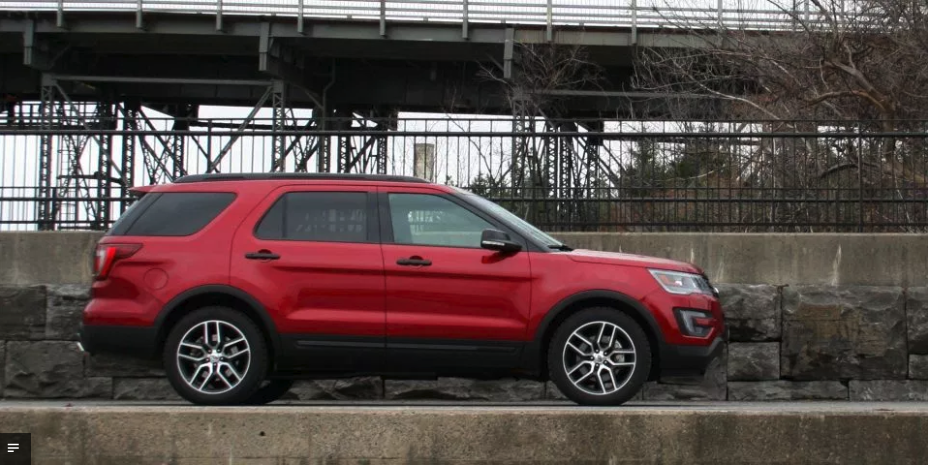Long-Term Test: 2016 Ford Explorer Sport – Part 1

Story and photo by John LeBlanc
It’s that time of the year again when Canadians start getting nervous about winter driving. And as much as we can prepare ourselves for dealing with snowy and icy road conditions, one way to manage your winter driving duties is to pilot a winter-ready vehicle like our 60-day test drive subject, the 2016 Ford Explorer Sport.
As Ford’s most recognizable nameplate next to the Mustang and F-Series, you probably know the Explorer – or probably owned one at some point. It started life in 1991 as a midsize SUV built off the Ford Ranger pickup chassis and quickly became one of the best-selling vehicles of the 1990s.
As part of a growing trend of families abandoning traditional sedans and wagons for SUVs, the Explorer ended up being one of Ford’s best-selling vehicles of all time. It remained a traditional SUV for three more generations, but recognizing the changes in the marketplace, the current Explorer arrived for 2011 underpinned by a car platform.
The Ford SUV’s makeover to a crossover saw measurable improvements in fuel economy, handling and space efficiency. And now, for 2016, the existing Explorer gets its first big refresh. Changes include more Range Rover-like exterior styling, interior updates, new safety features, retuned suspension components, more engine options and a new top-of-the-line Platinum model.
One reason why the Explorer remains popular is its wide range in price, powertrains and features. Rivals like the Chevrolet Traverse, Honda Pilot and Nissan Pathfinder only offer a six-cylinder engine. However, the Explorer’s engine menu includes a 3.5-litre V6 good for 290 horsepower and 255 lb.-ft. of torque, a new 2.3-litre turbo-four rated at 280 horsepower and 310 lb.-ft. of torque, and a range-topping 3.5-litre V6 with 365 horsepower and 350 lb.-ft. of torque.
For the cost-conscious winter driver, a base, front-wheel-drive Explorer with the 3.5 V6 (plus a proper set of snow tires) would make for a practical family hauler at $33,499. Even in starter form, the Explorer comes with a flexible 60/40-split folding second-row bench and 50/50-split third-row seven-passenger seating setup. And if you needed traction at all four wheels – say, to get to your skiing chalet or if the city snow plow forgets to do your street – AWD is a $3,000 add-on.
In that price range, the Ford competes well with the aforementioned mainstream rivals. But our $50,399 Explorer Sport came loaded with AWD, the top-of-the-line twin-turbo V6, leather seating, 20-inch aluminum wheels, sport-tuned suspension and a host of other convenience, luxury and safety features. The Sport sits just under the all-inclusive $59,099 Platinum and starts to compete with premium three-row crossovers like the Acura MDX, Buick Enclave and Infiniti QX60.
The accompanying pictures of the Ford do not lie. Like a lot of Canada, a proper winter has not arrived in my hometown of Ottawa just quite yet. For the first two weeks in our time in the Explorer, the snow dumped by the Zamboni in the parking lot at the local indoor rink has been the only sightings of the white stuff. Yet that’s still given us plenty of time to arrive at some initial impressions about the midsize Ford crossover.
It hasn’t snowed here yet, but that doesn’t mean our bulky winter wear hasn’t been left in the closet – that means the Explorer’s super-wide cabin offers plenty of puffy-jacket elbowroom. We’ve received zero complaints from second-row occupants, but while the two chairs in the Ford’s third row offer relatively good headroom, legroom is tight, to say the least. At least the cargo space with the Explorer Sport’s standard power fold-down third-row seating lowered is like an airplane hangar; the big Ford easily swallowed our family’s Christmas tree for the season.
Despite the stiffer suspension and low-profile tires, we have no plans to take the Explorer to our local track for some hot laps in the rest of our time with the Explorer. Yet for such a big vehicle, its ride and handling characteristics are relatively sophisticated. Suspension changes for 2016 have made the Explorer Sport feel more composed and tighter than before, making the crossover feel smaller than it actually is on the road.
The 2016 Explorer Sport also delivers a very comfortable and quiet ride over some of Ottawa’s worst pot-holed roads. Even with the tauter Sport model’s suspension and 50-section, Toyo Observe GS-i5 winter rubber Ford supplied, the Explorer acts like some of the pricier luxury crossovers on the market.
Keen drivers should like the Explorer Sport’s mill. The twin-turbo V6, mated to a six-speed automatic transmission, behaves like a V8. It delivers smooth and easy acceleration, but we’re also seeing V8-like fuel economy at 17.1 L/100 kilometres in mainly urban driving.
With all-wheel-drive standard, good ground clearance, state-of-the-art safety gear and seating for up to seven passengers, we are counting on the 2016 Ford Explorer Sport to be the perfect companion for our remaining six weeks of holiday shopping, road trips, family ski days and day-to-day family chauffeuring duties. Maybe, just maybe, we’ll get some real Canadian winter driving conditions by then as well.





![[del.icio.us]](https://www.straight-six.com/wp-content/plugins/bookmarkify/delicious.png)
![[Digg]](https://www.straight-six.com/wp-content/plugins/bookmarkify/digg.png)
![[Facebook]](https://www.straight-six.com/wp-content/plugins/bookmarkify/facebook.png)
![[Google]](https://www.straight-six.com/wp-content/plugins/bookmarkify/google.png)
![[Reddit]](https://www.straight-six.com/wp-content/plugins/bookmarkify/reddit.png)
![[StumbleUpon]](https://www.straight-six.com/wp-content/plugins/bookmarkify/stumbleupon.png)
![[Twitter]](https://www.straight-six.com/wp-content/plugins/bookmarkify/twitter.png)
![[Email]](https://www.straight-six.com/wp-content/plugins/bookmarkify/email.png)